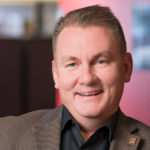This article appeared in the April 6, 2020, Sioux Falls Area Chamber of Commerce newsletter. It was written by Rob Swenson.
After 90 years in business, the company in Sioux Falls now known as TSP Inc. is undergoing a noteworthy change in ownership. It’s creating an employee stock ownership plan, or ESOP.
TSP, which provides architecture, engineering and design services for the construction industry, is the latest company in the Sioux Falls area to formally convert to employee ownership.
ESOPs remain relatively rare in the Sioux Falls area. There are roughly a dozen of them. However, as the local business community matures, more companies appear to be considering the business structure as an option in transitioning ownership.
It’s a trend even more pronounced at the national level, which is experiencing what is sometimes called “The Silver Tsunami,” a reference to the aging of American workers and business owners from the Baby Boom generation, according to The ESOP Association, an advocacy organization based in Washington, D.C. The Association has regional chapters across the United States, including one based in Minnesota that also covers the Dakotas.
Creating an ESOP is a way to reward employees who helped build a business, and a way to help ensure the continuity of a business in a community, said Patrick Mirza, communications director for The ESOP Association.
In some cases, communities as well as employees stand to lose a lot of economic benefits if an established business is closed or is sold to a competitor or equity firm that dismantles it.
“One of reasons that owners sell to an ESOP is that they’ve put so much time and effort into building their business and they’re proud of it. They’re proud of the culture, they’re proud of the quality of products and services that they provide and they don’t want to see that just go away,” Mirza said.
ESOPs essentially are retirement plans created to reward and incentivize employees. A trust is set up to acquire the business and work on behalf of employees’ best interests. Because they have an ownership stake in at least part of the business, employees have increased motivation to help the company prosper and grow in value. They can cash out when they leave the company or retire.
As well as helping preserve a business they built, owners who sell part or all of their company to an ESOP can reap tax benefits. The company itself also enjoys tax benefits.
In the case of TSP, the transition to an ESOP had been under consideration for several years before implementation began. The push increased about five years ago, under CEO Jared Nesje.
“In legacy firms such as ours, the owners needed to sell and get out. We looked at the new trends. Younger generations weren’t on board with an expensive buy-in. So, the model needed to change. One of the best solutions was an ESOP,” Nesje said.
“If we take care of our employees, our employees will in turn take care of our clients, and what we do as a business is then successful,” he said.
TSP has about 70 employees. In addition to Sioux Falls, the company has offices in Watertown, Rapid City, Omaha and Rochester, Minnesota. Initially, 51% of TSP will be owned by employees, and 49% will remain with existing shareholders. But the intent is to eventually be entirely owned by employees, Nesje said.
The ESOP “is another way to reward our team-member employees for the work that they do and a benefit based on the success of the firm,” said Brenda Moore, TSP’s controller.
THE BIG PICTURE
There are approximately 6,460 companies with ESOPs in the United States, according to the National Center for Employee Ownership (NCEO), which is based in Oakland, California. The ESOPs have assets that total nearly $1.4 trillion. The plans cover approximately 10.6 million active workers and 14.2 million participants overall.
Regional data from the center indicates there are 24 ESOPs in South Dakota that cover about 5,860 active workers and 7,000 overall participants. The center bases its statistics on federal data, which can be up to three years old.
The number of ESOPs nationally has been on a slight decline over the past decade, but the number of participants in ESOPs has been increasing. Factors such as business consolidations and growth are reflected in the numbers.
“I think employee-owned companies are doing pretty well right now. There seems to be an upward trend,” said Loren Rodgers, executive director of NCEO.
ESOPs can vary widely in the percentage of the company owned by employees. The NCEO considers a business to be an ESOP if it is established and employees own at least 50 percent, Rodgers said.
Tax advantages and business preservation are two of the primary reasons that businesses create ESOPs, he said. Protecting the legacy of business also can be a key factor.
“For a lot of people, the business they created is the biggest accomplishment of their lives. A lot of our members didn’t feel comfortable trusting that legacy to anyone except the employees who helped them build the business in the first place,” Rodgers said.
Jim Jarding, a tax partner with Eide Bailly LLP in Sioux Falls, has three business clients that have ESOPs. It’s not a common business structure, he said, but nor is it rare.
Eide Bailly has been having discussions with businesses lately about advantages ESOPs, but that hasn’t led to a rush of conversations, Jarding said.
“Typically where we would see it is in that exit-planning discussion for the current owners,” Jarding said. “Does it make sense for them to exit that way?”
For an ESOP to work, companies have to be big enough and have enough cash flow to handle the purchase as well as the coming and going employee-owners, Jarding said.
“An ESOP sounds attractive and there are some really good benefits,” he said. “The biggest hurdle tends to be the cost of setting that up and getting into that structure.”
Complying with federal regulations that govern employee ownership can be cumbersome and costly, too. An ESOP company has to be evaluated each year to determine its worth, for example, and shares of ownership have to be reallocated from time to time because of retirements.
“The companies we have are big enough for it to make sense. They have the right business model and the right cash-flow structure where they can make their ESOP work,” Jarding said.
Bierschbach Equipment & Supply is among the local companies with an ESOP in place.
Chad O’Donnell of Bierschbach recalls in-house discussions 25 years ago about the future of the company. At the time, O’Donnell worked in outside sales. Now he’s the president of the Sioux Falls-based company.
Bierschbach Equipment is a regional company that specializes in selling, renting, and servicing construction equipment. The company was started in 1979 by Don Bierschbach and three partners. O’Donnell recalls Don Bierschbach and his only remaining partner considering exit options in 1995 as they neared retirement. Some national companies were interested in buying the company, O’Donnell said, but Bierschbach wanted to reward his employees for helping his namesake business succeed.
So, Bierschbach and his partner created an ESOP. O’Donnell is glad they did. “It’s been fantastic. It’s been great,” O’Donnell said. “We made the right choice.”
Bierschbach now has 75 employees in five locations. When the company converted to an ESOP in 1995, in addition to its headquarters in Sioux Falls, the company had branches in Rapid City and Sioux City. Since the conversion, branches have been added in Fargo and Dickinson, North Dakota.
Overall, employee ownership has benefitted Bierschbach Supply in several ways, O’Donnell said. “It really gets employees engaged and thinking like an owner,” he said.
The ESOP also has helped the company retain high-quality employees. A third of Bierschbach employees have been with the company for 15 years or more, and many others have 10 years of experience, O’Donnell said.
Having an experienced workforce is usually considered a plus for businesses. However, it can be discouraging for new, promotion-minded employees because the pathways to increased responsibility might be blocked by veteran employees. O’Donnell acknowledges that can be an issue. But, overall, the pluses of an ESOP far outweigh the minuses, in his view.
“It’s been a great opportunity for our employees to be involved in the business, have a voice, and have some skin in the game,” he said.
Hy-Vee is among the other regional companies that are employee-owned. The Iowa-based grocery company promotes being 100% owned by employees.
Employee ownership is most commonly achieved through an Employee Stock Ownership Plan. But at Hy-Vee, it’s implemented through means such as employee bonuses, contributions to a 401(k) plan, and growth in the value of stock, according to the company.
The Midwestern grocery chain has been employee-owned since the creation of an employee trust fund in 1960. Dwight Vredenburg, who was the company’s president at the time, believed in rewarding employees and promoting autonomy within stores, said Shawn Brown, vice president for Hy-Vee’s northwest district.
Hy-Vee now has 246 stores in eight states, including seven stores in Sioux Falls. Every employee aged 19 and older who contributes to a 401(k) plan stands to benefit from the company’s success, Brown said.
“Being part of an employee-owned company gives our employees a sense of pride and ownership in the company and the work they do every day,” he said. The company’s ownership structure also enables the company to offer more autonomy and decision making to front-line employees.
Hy-Vee encourages new employees to “act like you own the place” when they enter a store—because they do. “Every one of our employees has a stake in this company and because of it, we are stronger, more innovative, and more autonomous than most retailers,” Brown said.
Nationally, ESOPs are most commonly found in companies in manufacturing; professional, scientific and technical services; and in the financial, insurance and real estate field.
Brookings-based First Bank & Trust, which has three branches in Sioux Falls, is among the financial institutions with employee ownership. In all, the bank holding company has 23 locations in South Dakota and Minnesota. The Fishback family, whose ancestors founded the bank, retains some ownership, but the bank has been partly owned by an ESOP for about nine years.
The ESOP has helped First Bank & Trust attract and retain good employees, which is significant considering the competition in the region for talented workers, said Jason Herrboldt, market president in Sioux Falls.
According to Herrbolt, companies that take on the challenge of creating and managing an ESOP tend to be employee centric. That seems to be the common denominator with ESOP companies, he said.
“It’s a very good way to get your employees to share in the fruits of the company,” he said. “Employees really act like they’re owners, and they are. They feel it. You can see that in their work product. You can see that in how they work with customers.”
As experts suggest, more companies are likely to at least consider ESOPs and other forms of employee ownership in the future. Employee ownership might not be common yet in Sioux Falls or South Dakota, but it’s a business structure that established itself as a proven, mainstream option.

